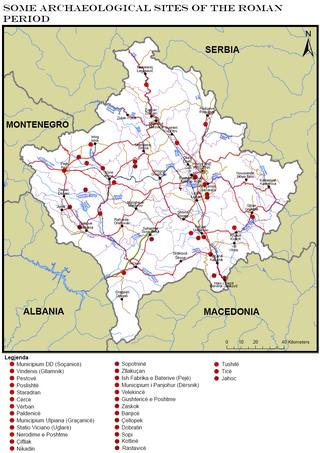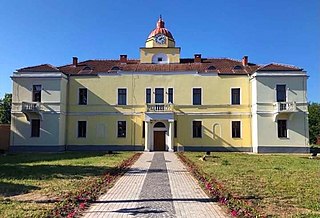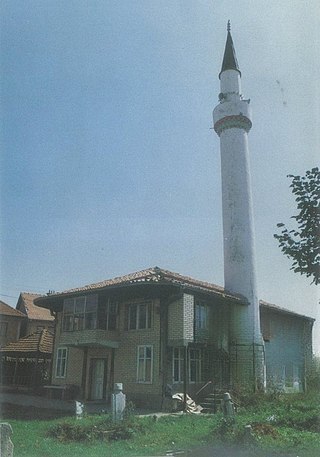
Vushtrri is a city and municipality located in the Mitrovica District in Kosovo. According to the 2011 census, the town of Vushtrri has 26,964 inhabitants, while the municipality has 69,870 inhabitants. Vushtrri is surrounded by the city of Mitrovica to the north, Podujevë in the east, Obiliq in the south, Drenas in the south-west, and Skenderaj in the west. The municipality of Vushtrri has 67 villages.

Trainkos is a private railway company based in Kosovo that also serves as the national rail carrier of the country. Established in 2011 alongside Infrakos, the two companies are the successors of Kosovo Railways, a public company that was split up and privatized. Trainkos offers rail service for both passengers and freight.

Pristina is the capital and largest city of Kosovo. It is the administrative center of the eponymous municipality and district.

The Vushtrri Castle or Old Tower are city fortifications in Vushtrri, Kosovo. It was the seat of despot Đurađ Branković (1427–1456). Later chroniclers are noted that the fort itself is derived from the times of Dušan, and that it is an old fortress with a tower in the middle of the town.
Tourism in Kosovo is characterized by archaeological heritage from Illyrian, Dardanian, Roman, Byzantine, Serbian and Ottoman times, traditional Albanian and Serbian cuisine, architecture, religious heritage, traditions, and natural landscapes. Kosovo is situated in south-eastern Europe. With its central position in the Balkans, it serves as a link in the connection between central and south Europe, the Adriatic Sea, and Black Sea.

Archaeology of Kosovo as a field of study and research was started in the second half of the 20th century. Kosovo's field of archaeology has developed in tandem with the historical study, studies of ancient authors' sources, classic philological studies, theological data research, topographic studies and ground survey, analysis of toponyms, deciphering of epigraphic and historiographic data. First data about antique monuments in Kosovo, were documented from the end of the 19th until the beginning of the Second World War, a time period when Kosovo was visited by researchers, guides, and archaeologists such as: Evans, Boue, Hahn, Kanitz, Tomaschek, Domaschevski, Arpad, Vulic, Jirecek, Patsch, Domenico Mustilli, etc.

The Roman heritage sites in Kosovo represent a multitude of monuments of material and spiritual culture, which reflect the Roman period in this region. Among them, a special place is occupied by those that represent the development of art, such as the plastic monuments that are more frequent, and at the same time occupy an important place, because with the presentation of figures in relief and with numerous inscriptions they speak to us enough for this period.
Monuments of Kosovo comprise all the monuments that are located in Kosovo.

Islamic monuments in Kosovo are commonly related with the Ottoman arrival in 1389, and respectively with their effective establishment in Kosovo in 1459. However, many historical evidences show that the first encounters of Islam with the Balkans happened well before the arrival of the Ottomans and their establishment in the Balkans. Because of its proximity to the centers of Islam, i.e., Middle East, the Byzantine Empire and parts of the Balkans, including the Albanian territories and Kosovo as well, were exposed to Islam as early as in the 8th century.

Part of a series of articles upon Archaeology of Kosovo

Viciana or Station Viciano was a Roman road station of unclear location, somewhere in Kosovo field.

Mitrovica District is one of the seven districts of Kosovo. Its administrative center and the largest city is Mitrovica. The district borders on the District of Peja to the south-west, the District of Pristina to the south and east, and the Serbia to the north and northwest.

Pristina's transport forms the hub of road, rail and air networks in Kosovo. The city's buses, trains and planes together all serve to maintain a high level of connectivity between Pristina many different districts and beyond. An analysis by the Traffic Police has shown that from 240,000 cars registered in Kosovo, around 100,000 cars are from the District of Pristina.

The Six Oaks of Likoshan are a grove of Quercus pubescens trees in the village of Likoshan in the Glogovac municipality, in the Drenica region of Kosovo. The very old trees are among Kosovo's few natural monuments. The locals call it Te Lisat Gjashtënjakë since they emerge from one root. In 2006, the organism was labeled a botanic monument under the official categorization MN/031. Besides its natural value, it has historical significance, since the Kosovo Liberation Army fought its first battle on 28 February 1998 by its trunk.

The Old Hamam of Vushtrri is one of the oldest and most prominent monuments in Vushtrri, Kosovo.

The Mahmut Gjinolli House is a cultural heritage monument in Vushtrri Municipality, Kosovo.

The Architectural complex in Maletaj is a cultural heritage monument located in Maletaj (Gumnisht), Vushtrri, Kosovo. This monument is of the "Architectural" category, approved with number.

Gazi Ali Beg Mosque is a mosque located in the old core of the city of Vushtrri,100 m away from the Old Hammam, as part of the Gazi Ali Beg Complex. Built in the 15th century, it is one of the oldest cultural heritage monuments in Kosovo.

Galica is a village administratively located in the Municipality of Vushtrri, Kosovo, but geographically situated in the Drenica region. The village covers an area of 443 hectares and is known for its numerous microtoponyms such as Katuni i Moçëm, Livadhi i Kolë Bibës, Kroni i Bajramit, among others, which testify to the village's history and culture.


















